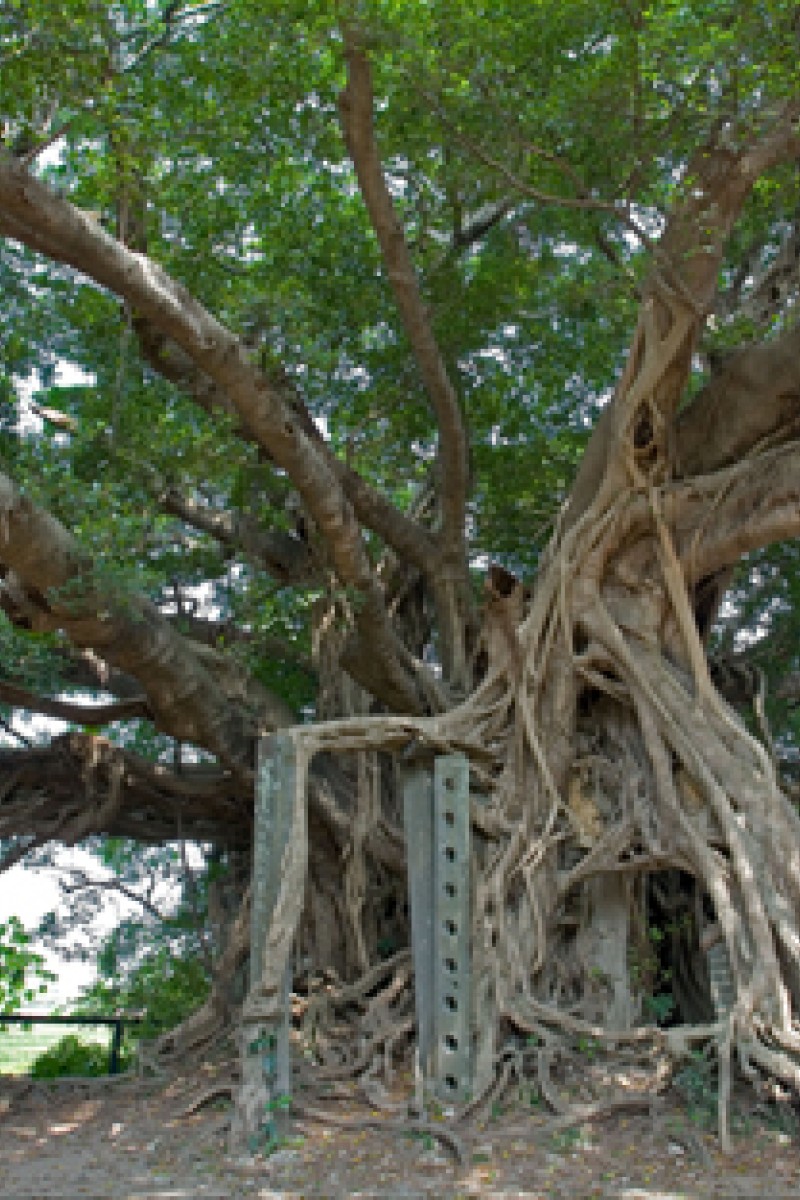 This massive banyan grew in the roof of an ancient study hall in Shui Mei Village, Kam Tin.
This massive banyan grew in the roof of an ancient study hall in Shui Mei Village, Kam Tin.It is one of the grandest of Hong Kong's magnificent ancient trees, several hundred of which are listed on the government's register of old and valuable trees. Most have stood their ground against storms and invading ants, only to face the modern menace of encroaching development and incompetence.
The gigantic camphor laurel (Cinnamomum camphora) is a champion tree by any definition. Boasting a robust 32-metre-wide crown of glossy, waxy leaves, it takes 10 adults linking arms to encircle its massive trunk.
The tree is a habitat in its own right. In spring, flocks of birds, butterflies and bees crowd its foliage full of white flowers and black fruit. Orchids also favour the tree for its scaly bark that traps vital water and nutrients. As for the villagers, they see the giant tree as their guardian angel and worship it with incense.
But years ago - no one remembers when - an intense fire gouged a child-size hole at its base, sending its health into decline.
"The blaze badly damaged the wood of the trunk, leaving it vulnerable to fungal and termite attacks," says Professor Jim Chi-yung, a dendrologist (a botanist specialising in trees) at the University of Hong Kong.
Two of the rarest trees in Hong Kong are a pair of four-metre Chinese dates (Ziziphus zizyphus) in Hong Kong Park. These were a gift from the the government of Henan province eight years ago. These shrubs decorate parks and gardens in more temperate parts of Asia. Chinese dates, which are not related to the date palms of the Middle East, bear red plum-like fruit that are dried and used in traditional Chinese remedies, tea and snacks.
Unfortunately, the trees were given a bad start for their journey to Hong Kong, as 90 per cent of their branches were trimmed. What's more, the trees are also not suited for Hong Kong's sub-tropical climate. "These are drought-hardy trees living in a habitat that is too warm and damp," Jim explains. "It will be hard for them to bounce back to their original glory."
For a Chinese Banyan (Ficus microcarpa), Hong Kong's weather is the least of its problems, being a native of the tropics. Kowloon Park has a specimen which is about 250 years old - it was a grand old tree when the park was built around it.
In the wild, banyans grow from seeds that lodge in the branches of other trees, perhaps dropped by a passing bird. They then grow to eventually overwhelm their host. The species grow beard-like aerial roots forming secondary trunks once they reach the soil.
Banyans can live for 1,000 years, but the one in Kowloon Park saw a third of its trunk collapse in 2007 - a decade after it was dubbed Hong Kong's king of urban trees. Its trunk now tilts at a 45-degree angle and only a tenth of its leaves remain.
The tree is yet another victim of mismanagement, Jim says. In this case, the tree's roots were encased in concrete during a park upgrade. "It would be like sticking your head in water," Jim says. "Compared to how robust it looked 15 years ago, the tree is in dismal shape and might not survive."
One of Hong Kong's most remarkable banyans, at least 150 years old, occupies the site of an abandoned Qing dynasty study hall in Kam Tin that it consumed.
Unfortunately, it shares a similar fate to its Kowloon Park relative: the government hacked off part of its roots to build a new road and playground around it.
The government has to learn from previous mistakes if it truly wants to protect Hong Kong's old trees, Jim says. "If Hong Kong people are to enjoy natural, beautiful and thriving trees, then the government must adopt far-sighted management strategies."
